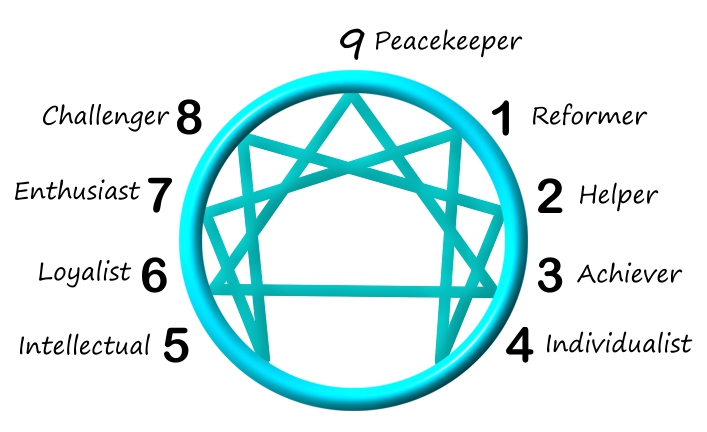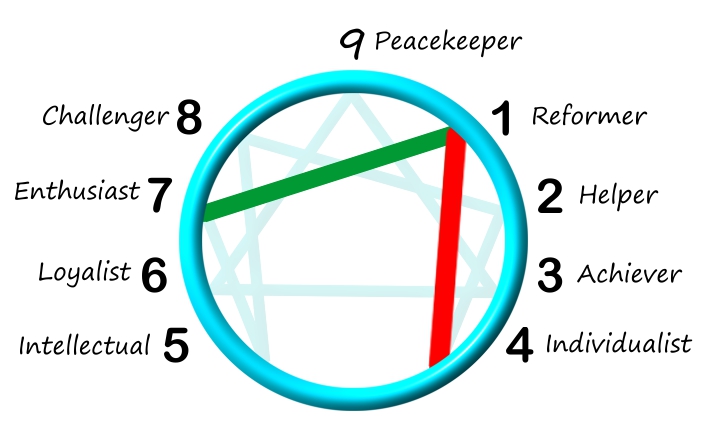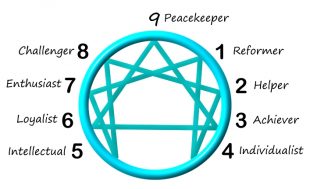
THOSE LINES MEAN SOMETHING!
Here’s a big warning.
If you didn’t learn the basics of the Nine Personality Types, and haven’t memorized them somehow, it’s best not to proceed. You can proceed if you want to, but trust me on this, it’ll just start getting a bit more confusing because I’m not going to take too much time to explain each personality type in detail from here on out. So if I say Type Nine, I will expect you to know already what a Type Nine “Peacekeeper” looks like.
Moving on.
So, as the title says, those lines in there mean something. In fact, they mean a lot. They give us a solid idea of how each personality reacts to each other, and how a certain personality may “look” when they are healthy, unhealthy, or triggered. I put look in quotes because what you may observe to the naked eye, would be a facade of their true personality type.
Let me explain.
 Ones look like healthy Sevens when healthy, but are not sevens.
Ones look like healthy Sevens when healthy, but are not sevens.
For example, a healthy Type One “Reformer” may act like a Type Seven because they may have lots of hobbies, look as if they are open-minded, and give you the impression that they are very easy going. You may believe that person —–stopped—–
But deep down within, they could be a highly judgemental personality who greatly fears doing the wrong thing. So they could be a Type One.
 Ones look like unhealthy Fours, when they are triggered, or unhealthy.
Ones look like unhealthy Fours, when they are triggered, or unhealthy.
On the opposite side of the spectrum, when a Type One is triggered, or unhealthy, they look like a Type Four “Reformer”, unsure of themselves, searching for a purpose or meaning to their life.
I label these lines into two categories:
GROWTH and TRIGGERED
And it would be best if you tried to memorize the direction of these lines so you can call on your memory banks when writing characters. The easiest way to do this is to memorize the TRIGGERED direction of the Enneagram, which is the way personalities deteriorate, which is, starting from the top:
1-4-2-8-5-7-1
and
9-6-3-9
Memorizing this is quite easy, and here’s the method I used.
Just memorize the number 14, double that is 28.
571 is a type of Levis Jeans that no man should wear as it’s the model number for Women’s Slim Fit.
96.3 is a very common radio station number in most States; I have no idea why. But more than likely, you’ve already memorized that number. Just add a 9 to it.
These numbers are the direction that personalities disintegrate; the opposite will give you the number they grow at. Once you memorize the disintegration direction, you can reverse the numbers in your head.

For a Type One “Reformer”, they may look open-minded like a Seven when healthy, and searching for a meaning in life like a Type Four, when triggered.
WHAT TO USE THE LINES FOR?
TO IDENTIFY PERSONALITY TYPES ACCURATELY – When you first learn about the Enneagram, you may just start trying to identify everyone and your pet’s personality type. That’s fine and even good practice. Often, we can fall into the trap of identifying a triggered behavior while ignoring their base fear that they operate from.
For example, say you meet someone who has lost direction and purpose in their life, and they are struggling to find their identity. You immediately conclude they are a Type Four “Individualist”, but in reality, they are a Type One “Reformer”, and what you were witnessing was their triggered response to an event.
I’ll focus a bit more on identifying personalities in another article, but understanding the lines of growth and disintegration (triggered), will help you narrow down what personality type that individual may be.
TO CREATE THREE-DIMENSIONAL CHARACTERS – If you don’t use the Enneagram to create characters, and you are not one of the naturally gifted writers who understand human behavior, then you will create unbelievable characters who are simply different levels of angry, or different levels of happy.
With growth and triggered lines, now we can understand how a particular character will act in certain situations.
Let’s go back to the Type One “Reformer” who is all about rules, law and order, a compulsive fixer who needs to right the wrong in his mind. When he is triggered, not only will he tend to be argumentive, and may break the rules, but like an Unhealthy Type Four, he may begin to think metaphorically, and feel cast out by society. This is the character formula for Batman. Batman can truly look like a Type Four because he embraces the dark, lives in the shadows of society, and has created an alternative identity to fight crime. In a way, he’s much like a rockstar who creates an alternative identity to perform on stage, such as Prince.
But Batman is not searching for an identity, and he knows his purpose in life, so he’s not a Type Four. In fact, he is an unhealthy Type One, which is much different from a healthy or average version of a Type One that is triggered (that is for a later post). Batman has rules; you cross them, you’re against him, even if you’re a superhero.,
This is only the tip of the iceberg of how we can use the Enneagram to interpret Batman’s character, who is overpowered by his fear of making the wrong choice.
Using the Enneagram, classifying him as a Type One “Reformer”, we have pretty much nailed his character and can throw into a story, and author a story that fans will most likely classify as canon (as long as we stay true to the lore).
But if we don’t understand personality, a novice writer will say, “Wouldn’t it be cool if Batman was angry, and then he beat up the Joker this way?” While that novice writer may be able to tap out an interesting scene, he won’t know enough about Batman’s character to propel him through a sensible story arc.
TO UNDERSTAND THE SMALL NUANCES BETWEEN PERSONALITY TYPES – Let’s stick to the Type One “Reformer” personality type. There is a big difference between an Unhealthy Type One, who may act like a Type Four, and an actual Unhealthy Type Four.
The main difference between the two is that a Type One Personality is usually an extrovert, while a Type Four would be an introvert. A Type One would be willing to argue moral decisions, usually on topics not about themself. In contrast, a Type Four will complain about being offended, and talk about personal experiences and themself. Also, an unhealthy Type Four may begin to bargain for love and attention.
These little nuances will help you create extremely emotionally complicated characters, that the audience will fall in love with because they’re real.
Now, onto the next topic, character growth.



